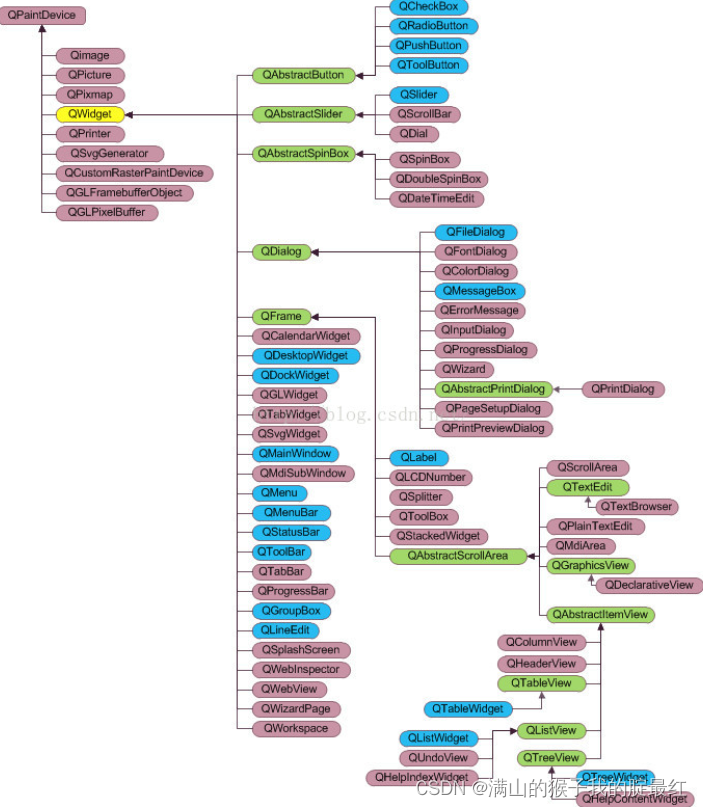1、QWidget类
QWidget类时所有组件和窗口的基类。内部包含了一些最基础的界面特性。

常用属性:
1.1修改坐标
- x : const int
横坐标,每个图形的左上角为定位点,横轴的零点在屏幕的最左边,正方向向右。
- y : const int
纵坐标,每个图形的左上角为定位点,纵轴的零点在屏幕的最上面,正方向向下。
虽然横坐标与纵坐标无法直接修改,但是可以通过下面的函数间接修改。
需要注意的是,位置包含边框。
// 参数1:新的横坐标// 参数2:新的纵坐标voidmove(int x,int y)
1.2修改宽高
- width : const int
宽度
- height : const int
高度
无法直接进行修改,但是通过函数:不包括边框
// 参数1:新的宽度// 参数2:新的高度voidresize(int w,int h)
下面的函数可以同时设置上述四个属性:
voidsetGeometry(int x,int y,int w,int h)
1.3修改样式 stylesheet
- styleSheet : QString
样式表,QString为Qt的字符串类型,样式表使用QSS语法(模仿的CSS语法)。
#include "dialog.h"// 构造函数定义// parent 参数Dialog::Dialog(QWidget*parent):QDialog(parent)// 透传构造{// 移动w窗口到200,200位置move(200,200);// 设置窗口宽度,以及窗口高度resize(200,600);// 设置样式表(设置窗口背景为红色)setStyleSheet("background-color:red");qDebug()<<"构造函数 hello world";}// 析构函数类外定义Dialog::~Dialog(){}
2、添加若干子组件
上面的窗口中什么都没有,实际上可以向窗口中添加若干组件,实现不同的显式和交互效果。本节以QPushButton(按压式按钮)组件。
QPushButton要持续存在,直到窗口关闭,因此使用堆内存。按照C++的内存回收机制,子组件应该在父窗口的构造函数中创建,在析构函数中销毁。
QPushButton构造函数:
// 参数1:按钮上显式的文字// 参数2:现阶段可以认为是给当前组件设置父窗口QPushButton::QPushButton(constQString& text,QWidget* parent =0)
dialog.h
#ifndef DIALOG_H#define DIALOG_H#include <QDialog>#include <QDebug>#include <QPushButton>//按钮头文件class Dialog : public QDialog{ Q_OBJECTpublic: Dialog(QWidget *parent = 0); ~Dialog(); QPushButton *btn; // 成员变量};#endif // DIALOG_H
dialog.cpp
#include "dialog.h"// 构造函数定义// parent 参数Dialog::Dialog(QWidget*parent):QDialog(parent)// 透传构造{// 移动w窗口到200,200位置move(200,200);// 设置窗口宽度,以及窗口高度resize(200,600);// 设置样式表(设置窗口背景为红色)setStyleSheet("background-color:red");// 创建一个按钮对象,头文件<QPushButton>, 且头函数内声明,主函数调用// 参数1:按钮显式的内容// 参数2:在当前对象窗口中创建一个按钮,this是指向当前对象 btn =newQPushButton("你好",this); btn->move(50,200);qDebug()<<"构造函数 hello world";}// 析构函数类外定义Dialog::~Dialog(){// C++内存回收 delete btn;}
以下是一个预设的QPushButton的样式表,可以根据实际情况自行改动。
#define QPushButton_STYTLE(QString("\/*按钮普通态*/\QPushButton\{\ font-family:Microsoft Yahei;\ /*字体大小为20点*/\ font-size:20pt;\ /*字体颜色为白色*/\ color:white;\ /*背景颜色*/\ background-color:rgb(14 , 150 , 254);\ /*边框圆角半径为8像素*/\ border-radius:8px;\}\/*按钮悬停态*/\QPushButton:hover\{\ /*背景颜色*/\ background-color:rgb(100 , 137 , 255);\}\/*按钮按下态*/\QPushButton:pressed\{\ /*背景颜色*/\ background-color:rgb(14 , 135 , 10);\ /*左内边距为3像素,让按下时字向右移动3像素*/\ padding-left:3px;\ /*上内边距为3像素,让按下时字向下移动3像素*/\ padding-top:3px;\}"))
推荐两个配色网站:
在线颜色选择器 | RGB颜色查询对照表
Color Palette Generator - Create Beautiful Color Schemes
dialog.h
#ifndef DIALOG_H#define DIALOG_H#include <QDialog>#include <QDebug>// 头文件#include <QPushButton>// 按钮类#define QPushButton_STYTLE(QString("\/*按钮普通态*/\QPushButton\{\ font-family:Microsoft Yahei;\ /*字体大小为20点*/\ font-size:20pt;\ /*字体颜色为白色*/\ color:white;\ /*背景颜色*/\ background-color:rgb(14 , 150 , 254);\ /*边框圆角半径为8像素*/\ border-radius:8px;\}\/*按钮悬停态*/\QPushButton:hover\{\ /*背景颜色*/\ background-color:#87e2ff;\}\/*按钮按下态*/\QPushButton:pressed\{\ /*背景颜色*/\ background-color:#0a89b2;\ /*左内边距为3像素,让按下时字向右移动3像素*/\ padding-left:3px;\ /*上内边距为3像素,让按下时字向下移动3像素*/\ padding-top:3px;\}"))classDialog:publicQDialog{ Q_OBJECTpublic:Dialog(QWidget*parent =0);~Dialog();private:QPushButton* btn;// 成员变量};#endif // DIALOG_H
dialog.cpp
#include "dialog.h"Dialog::Dialog(QWidget*parent):QDialog(parent){// 移动w到200,200的位置move(200,200);// 设置w的宽高resize(200,600);// 创建子组件对象// 参数2同时使用了this指针+多态的用法 btn =newQPushButton("你好",this); btn->move(50,200); btn->resize(100,100);// 设置样式表给按钮对象,样式表在头函数内声明。 btn->setStyleSheet(QPushButton_STYTLE);}Dialog::~Dialog(){// C++内存回收 delete btn;}
版权归原作者 满山的猴子我的腚最红 所有, 如有侵权,请联系我们删除。